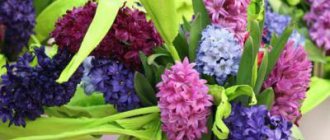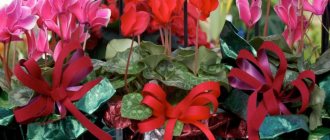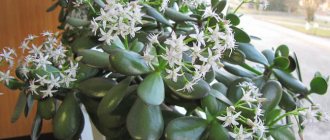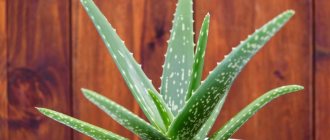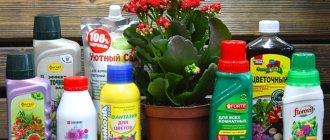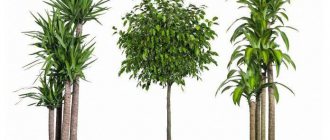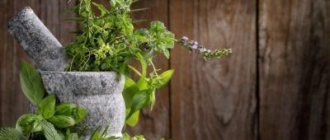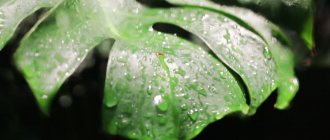Gardenia
Gardenia is an unusually elegant flower that belongs to the madder family. In terms of sophistication, it is compared to camellia. In addition to its chic appearance, it has a charming scent. Just one pot of the plant will fill the entire room with a subtle aroma.
In nature, gardenia grows on the Ryukyu Islands, as well as in the forests of Japan, India and China. It is popularly called “Cape jasmine”. Under natural conditions it reaches a height of 2 m, in rare cases – 3 m.
The leaves of the plant are dark green in color, shiny, with a dense texture and pointed tips. Indoor specimens look neat and compact, the height is 0.5 m, and are beautiful even in the absence of flowering.
The plant owes its name to A. Garden, a doctor and naturalist from America. It was he who cultivated this species.
There are specimens with white and cream flowers, regular or double. The diameter of each is up to 10 cm. The flowers are collected in inflorescences or arranged singly. They emit a pleasant aroma. Flowering occurs from July to October. Under good conditions and care, the plant becomes covered with gorgeous buds.
More than 250 species of gardenia are found in nature. However, flower growers grow only a few varieties: profuse, regal, jasmine, radicans, Kula, citriodora. In indoor conditions they contain mainly jasmine gardenia. Large double white flowers are formed on its shoots.
Here's what you should know about gardenia:
- Among flower growers it has gained fame as a demanding plant.
- Does not like rearrangements and changes in location. Until death.
- Prefers light, but gets burned when exposed to direct sunlight. The ideal place is a bright room on the south side.
- The optimal temperature is 18-22 C.
- Cold and drafts cause flowers to fall off. It has a hard time surviving sudden temperature changes.
- Avoid watering with cold water. The plant will react by yellowing the leaves.
- In a shaded place, the buds may dry out and fall off. Rooms on the north side require an additional light source.
- At temperatures above 24 C, weak shoots begin to grow, on which buds do not form.
To make friends with a flower, you will need to make an effort and customize the content. Gardenia can complement any interior. A beautiful, neat bush will decorate the room, make it cozy and fill it with a pleasant fragrance. Will be an unforgettable holiday gift.
The most beautiful low-growing annuals
A living border, ridge or front garden cannot do without low-growing flowering plants.
In warm colors
Yellow flowers are a symbol of joy, prosperity, prosperity. They radiate positivity, they exude freshness and vigor. Reds and oranges radiate warmth and passion. Pink evokes tenderness and evokes a romantic mood.
Antirrinum, known to everyone since childhood as snapdragon, is a popular garden crop. His photo:
Blooms all summer and autumn. Planted as a border, in flower beds. Extremely unpretentious, maximally decorative in the sun and partial shade
Godetia, like many other annuals, blooms for more than 2-3 months. Photo:
Suitable for both borders and flower beds
Marigolds are the favorites of all gardeners. Photo:
Their advantages are not only a long flowering period and versatility of use. They are good for the soil and even repel some insect pests.
Gazania, which grows no more than 30 cm, pleases with large, bright flowers, spectacular in the lower tier of a flower bed or in border plantings. Photos of gazanias:
Blooms from July to late summer.
Cephalophora - strawberry grass - lush greens and bright balls of inflorescences form a luxurious border and complement the flowerbed. Loves the sun, blooms until August. Her photo:
It can be either a canopy or a ground cover form.
Garden annuals in cool colors
Blue, blue, and violet colors not only bring coolness and freshness. These noble colors can calm you down and set you in a philosophical mood. Low-growing cool-colored annuals that bloom all summer include:
Ageratum is a spectacular plant for border plantings, borders, and flower beds. Photo:
Blooms in sunny areas from June to autumn
Attention, ageratum is a poisonous plant
Angelonia, growing to a maximum of 30 cm, is so good that it will not only decorate any flower arrangement, but will also compete with taller tapeworms. Photo:
With white flowers
White color, being neutral, harmonizes with both warm shades and cold tones, shading and emphasizing the design of the flower garden.
Among the low-growing plants with white flowers, the following stand out:
Anemone with luxurious white inflorescences reminiscent of a poppy. Photo:
Many of the listed crops are found both in warm colors and in the cold spectrum of the palette, which makes it possible to combine different colors of one type of plant.
Gloxinia
Famous perennials starting with the letter g: gardenia, hibiscus, glottiphyllum, graptopetalum. Gloxinia, which is characterized by a tuberous root system, also belongs to long-living plants.
Up to 20 species of gloxinia grow in the wild. Homeland: Brazil, tropical South America. Grows on river banks, slopes, rocks and forest clearings. The wild plant is more like a shrub or grass. Artificially bred hybrid varieties that are adapted to life at home are grown indoors.
The flower began to be cultivated thanks to the work of the German doctor and botanist Benjamin Gloksin. While traveling in Brazil, he noticed an unusual flower that looked like a large bell, and made a detailed description. This is how the flower got its name.
Gloxinia is famous for its variety of shapes and colors of buds. Beautiful flowers have made the plant extremely popular among professionals and amateurs. Some gardeners collect this species. There are varieties with smooth and double flowers of purple, white, blue, pink, large and miniature sizes.
The leaves are velvety green or dark green in color. There are up to 50 flowers on one plant. The spectacle is amazing and unforgettable. A subtle soft aroma emanates from the foliage.
There are quite large gloxinias, which complicates the task of the gardener and makes it difficult to locate in small apartments. However, there are also dwarf specimens. Height ranges from 10 to 70 cm.
Gloxinia has a pronounced dormant period in winter. Its ground shoots die off, and the root system “falls asleep.” Those who do not know this feature of the flower may think that it has died. In spring there is an awakening, leaves grow, then the stems lengthen. Flowering begins in May and stops in September. In autumn you can get small seeds.
Caring for gloxinia is simple and consists of the following:
- Gloxinia is heat-loving, the suitable temperature for it is 18-23 C. A good solution is to place the pot in the kitchen, where it is warm and has optimal humidity.
- Be sure to use settled water for irrigation. Water tender young shoots carefully. The liquid should be lukewarm.
- An increased need for moisture occurs before hibernation. In autumn, watering is carried out more often.
- The plant does not tolerate drafts.
- With enough light, the leaves will grow to the sides, and this is correct. When there is a lack of lighting, they stretch upward.
- The flower should be fed once every 1.5-2 weeks from spring to August.
What to do during winter dormancy? Gloxinia must be placed in a cool, dark place. Some gardeners prefer to store the tuber in a plastic bag. Use the vegetable compartment of the refrigerator for storage.
Cool cheat sheet for color combinations
Botanical description of plants whose names begin with the letter p with photo
The right combination of colors is one of the important components of a perfect image and a stylish and holistic interior. That’s why we decided to share a cheat sheet with which you definitely won’t go wrong when choosing clothes or apartment design.
Scheme No. 1. Complementary combination
Complementary, or complementary, contrasting colors are colors that are located on opposite sides of the Itten color wheel. Their combination looks very lively and energetic, especially with maximum color saturation.
Scheme No. 2. Triad - a combination of 3 colors
A combination of 3 colors lying at the same distance from each other. Provides high contrast while maintaining harmony. This composition looks quite lively even when using pale and desaturated colors.
Scheme No. 3. Similar combination
A combination of 2 to 5 colors located next to each other on the color wheel (ideally 2-3 colors). Impression: calm, inviting. An example of a combination of similar muted colors: yellow-orange, yellow, yellow-green, green, blue-green.
Scheme No. 4. Separate-complementary combination
A variant of a complementary color combination, but instead of the opposite color, neighboring colors are used. A combination of the main color and two additional ones. This scheme looks almost as contrasting, but not so intense. If you are not sure that you can use complementary combinations correctly, use separate-complementary ones.
Scheme No. 5. Tetrad - combination of 4 colors
A color scheme where one color is the main color, two are complementary, and another one highlights the accents. Example: blue-green, blue-violet, red-orange, yellow-orange.
Scheme No. 6. Square
A combination of 4 colors equidistant from each other. The colors here are dissimilar in tone, but also complementary. Due to this, the image will be dynamic, playful and bright. Example: purple, red-orange, yellow, blue-green.
Combinations of individual colors
- White: goes with everything. The best combination with blue, red and black.
- Beige: with blue, brown, emerald, black, red, white.
- Grey: with fuchsia, red, purple, pink, blue.
- Pink: with brown, white, mint green, olive, gray, turquoise, baby blue.
- Fuchsia (deep pink): with grey, tan, lime, mint green, brown.
- Red: with yellow, white, brown, green, blue and black.
- Tomato red: blue, mint green, sandy, creamy white, gray.
- Cherry red: azure, gray, light orange, sand, pale yellow, beige.
- Raspberry red: white, black, damask rose color.
- Brown: bright blue, cream, pink, fawn, green, beige.
- Light brown: pale yellow, creamy white, blue, green, purple, red.
- Dark Brown: Lemon Yellow, Blue, Mint Green, Purple Pink, Lime.
- Tan: pink, dark brown, blue, green, purple.
- Orange: blue, blue, lilac, violet, white, black.
- Light orange: gray, brown, olive.
- Dark orange: pale yellow, olive, brown, cherry.
- Yellow: blue, lilac, light blue, violet, gray, black.
- Lemon yellow: cherry red, brown, blue, gray.
- Pale yellow: fuchsia, grey, brown, shades of red, tan, blue, purple.
- Golden yellow: gray, brown, azure, red, black.
- Olive: orange, light brown, brown.
- Green: golden brown, orange, light green, yellow, brown, gray, cream, black, creamy white.
- Salad color: brown, tan, fawn, gray, dark blue, red, gray.
- Turquoise: fuchsia, cherry red, yellow, brown, cream, dark purple.
- Electric blue is beautiful when paired with golden yellow, brown, light brown, gray or silver.
- Blue: red, gray, brown, orange, pink, white, yellow.
- Dark blue: light purple, light blue, yellowish green, brown, gray, pale yellow, orange, green, red, white.
- Lilac: orange, pink, dark purple, olive, gray, yellow, white.
- Dark Purple: Golden Brown, Pale Yellow, Grey, Turquoise, Mint Green, Light Orange.
- Black is universal, elegant, looks in all combinations, best with orange, pink, light green, white, red, lilac or yellow.
Based on decor-design materials
Glottiphyllum
An unusual yellow flower starting with the letter g is glottiphyllum. This perennial succulent plant, which can grow in areas with arid climates, belongs to the Aizov family. Features a wide variety of shapes.
The plant grows in southern and southwestern Africa. For growth, flowers choose the Karoo plateaus, semi-desert areas and dry river beds. The soil in these areas is fertile, although arid. Glottiphyllum tolerates temperature changes well. In the natural environment, the air cools to 0 C at night.
There are about 20 varieties and subspecies. The plant has a shallow root system; water is accumulated and stored by shoots. The leaves are lush green or dark green. Sometimes there are specimens with a blue or reddish tint. Some have specks and dashes. Sheet plates are round and cylindrical.
Single flowers grow on a short stalk, with a bunch of stamens inside. The bud itself is quite large. The flower looks like a large dandelion and exudes a delicate fragrance. The petals are predominantly yellow and glossy. Sometimes there are specimens that are white, golden, or with an orange tint.
An interesting feature of glottiphyllum is its two-time, albeit short-lived, flowering. The first time occurs in May, and the second time in September. The fruit of the plant is a capsule filled with seeds.
Glottiphyllum is not a demanding plant; it is very easy to maintain indoors. The pot should be clay and shallow; it must have drainage holes. The plant does not feel well in plastic.
It is recommended to replant young plants annually. As they grow, it is enough to carry out the procedure once every few years.
Glottiphyllum can be a significant acquisition for an avid gardener. This unusual flower will fit perfectly into your home environment.
Berries in flower bouquets
When making bouquets, berries are added in summer and autumn during the growth or ripening of fruits. In summer bouquets, unripe fruits are popular, which will not stain the bride’s dress, and in autumn, hard fruits of bushes and trees are popular.
In summer floristry you can find blackberries, strawberries, raspberries, and St. John's wort. Fruits in autumn floristry have the same names, like shrubs and trees - hawthorn, viburnum, rowan, rose hip. Many of these berries can be added to bouquets year-round.
Let's look at the description of some berries in more detail.
Blackberries and raspberries
Blackberries and raspberries have an interesting shape. The refreshing appearance and sweet aroma of berries will be a pleasant addition to any bouquet. Blackberries and raspberries symbolize wealth and happiness, which is why they are popular in wedding floristry.
Please note that in this case, blackberries and raspberries have only a decorative meaning in the bouquet, unlike edible bouquets. We wrote about them here (opens in a new window). Fruit and vegetable floristry involves practicality, when the fruits, berries or vegetables used in the bouquet can be eaten within 1-2 days.
St. John's wort
St. John's wort or Hypericum is a medicinal plant with bright yellow flowers. But the fruits of the plant are popular in bouquets. Bright red St. John's wort berries fit delightfully into bouquets with irises, callas, sunflowers and roses. The unripe fruits of white, green and yellow shades of St. John's wort are suitable for creating romantic bouquets.
Kalina
Red viburnum has long been a decoration for weddings. Viburnum branches were hung indoors and placed on the table, and added to the bride’s bouquet. Nowadays, florists add viburnum to bouquets, emphasizing the charm of the bride. In bouquets, viburnum goes well with gerberas, callas, poppies, and roses.
Strawberry
Fragrant strawberries in a flower arrangement symbolize fertility. When adding to a bouquet, choose dense and slightly unripe berries. Strawberries go well with flowers in pastel shades, but you can also add bright plants such as lilies, roses, and eustomas.
Rowan
Orange or red rowan berries look great in an autumn bouquet, either as a gift or for the bride. Rowan berry clusters can be added to any floral arrangement, but they look more interesting in bouquets of white, burgundy, orange and purple flowers.
Graptopetalum
Graceful graptopetalum will be a real pearl of the flower collection. This flower has an extraordinary appearance. Thanks to the Mexican explorer Alfredo, Lau was brought to Europe.
The plant, like glottiphyllum, is a succulent. Able to accumulate water and use it economically. Homeland - Mexico. It grows near coniferous forests in dry, rocky areas.
Graptopetalum can survive without moisture for a long time, but is also heat-loving. Characterized by slow growth and a long flowering period.
Graptopetalum has flat, fleshy leaves arranged in rosettes. Unusual leaves and flowers add beauty to the plant. Graptopetalum will delight the owner with long colorful flowering from April to the end of summer.
Depending on the variety, the buds are pink, white, red or blue. Yellow or cream specks and streaks may be present. The most common varieties are graptopetalum paraguayan, filamentous and beautiful.
Caring for a flower will be easy even for a novice gardener.
The plant tolerates indoor microclimate well. The main requirement of graptopetalum is the correct temperature regime. In the spring-summer season, it is advisable to warm the air to 23-27 C.
In cold seasons, the plant enters a dormant period. At this time, a temperature of no more than 15 C (but not less than 10 C) is required. The pot is placed on the northern windowsill or insulated loggia.
The flower tolerates poor watering and low air humidity well. Does not require spraying with water.
Graptopetalum is perfect for keeping indoors. Will become a spectacular home decoration. Also grown in greenhouses.
NAME A FLOWER WITH THE LETTER G? (as many options as possible)
Wintergreen – harmony, “Be calm”, “Contain your emotions”
Carnation - charm, female love, passion, honor and freedom, fidelity... The meaning of carnations in the language of flowers can be very different: it all depends on their color. Carnation (pink) – “I will never forget you”, a symbol of maternal love. In the United States, pink carnations are traditionally given as gifts for Mother's Day. The person who gives carnations wants to express his gratitude to you and assure you that under any circumstances you can count on his help and support. Carnation (red) – victory, success, leadership. It is customary to congratulate authoritative and respected people with a large bouquet of red carnations. It is better to give red carnations to your loved ones in mixed bouquets. Carnation (white) – wishes of good luck and success in everything. “May all your wishes come true.” If you were given white carnations as a gift, this indicates that you are considered a very charming, bright and positive person. Carnation (yellow) – “Are you avoiding me? “, “Are you offended? “, “I want you to be more attentive.”
Dahlia is a whim, inconstancy, a passing hobby. The person giving dahlias says: “I really like you, but I don’t promise anything,” “I’m not ready for a serious relationship,” “Why complicate everything? “
Geranium - stupidity, recklessness. “You are a very frivolous person,” “It’s time to settle down.”
Gerbera – mystery, smile, flirtation, optimism. The person giving gerberas expresses his sympathy for you and hints that you will have a lot of fun together. Gerbera is a universal positive gift: for friends, lovers, colleagues... Feel free to choose these flowers if you want to share your great mood with someone or give a compliment.
Hyacinth – play, curiosity, wisdom, unpredictability. The range of emotions that can be expressed with the help of these flowers is quite wide - a lot depends on the shade of hyacinths. But you can be sure of one thing - you won’t be bored with the person who gave you hyacinths. Thanks to him, your life will become brighter. Hyacinth (blue) – self-confidence, calmness, poise. “I know why I like you”, “I have no doubt that you are right for me” Hyacinth (red or pink) - “I know what you want”, “Many pleasant surprises await you”, “Our whole life - a game. “Hyacinth (white) – constancy. “I am forever fascinated” Hyacinth (yellow) – an attempt to hide jealousy and mistrust
Gypsophila – caution, timidity. However, in a mixed bouquet, gypsophila, as a rule, is a kind of accessory, serves to give volume to the flower work and does not carry a semantic load.
Gladiolus – “I am truly sincere”, “Fear nothing”, flower of gladiators. The giver of gladioli is a strong, reliable person who does not accept compromises.
Wisteria – “Welcome! “Give wisteria to the person to whom you want to say, “I am always glad to see you!” “
Gloxinia – love at first sight, “My feelings are stronger than me”
Guzmania
Another interesting unusual indoor flower is called guzmania. This plant came to us from the tropics. Grows in the forests of Central and South America. More than 100 species are represented in the natural environment.
The plant is equipped with long glossy leaves, which are collected in a rosette near the roots. A beautiful bright flower appears from the center. The color is fiery red, with yellow areas. Guzmania blooms for 4 months. However, after that it dries out.
Guzmania reed is most often grown indoors. It is a herbaceous plant with soft leaves. The flower market offers compact hybrid species with a height of no more than 30 cm.
Epiphytic guzmania is also kept in houses. The leaves of the flower form a rosette resembling a glass. I fell in love not for its flowering, but for its beautiful succulent leaves.
The basics of care are as follows:
- A suitable place for guzmania is a home greenhouse or an indoor florarium. It is easy to maintain constant air humidity and temperature there.
- In the warm season, watering is increased, and in winter it is reduced.
- The ideal temperature is 19-21 C. Humid air is welcome.
- Special soil is needed - a mixture of crushed sphagnum roots, ferns and charcoal.
- To stimulate flowering, they resort to a trick. Place the guzmania in a bag of spoiled apples for a couple of days. Make sure there is no mold on the fruit. The released acetylene will promote the formation of flowers.
If you master the care of guzmania, the plant will delight you with its beauty and originality. A tropical flower will add to the collection of exotic representatives of the plant world.
Heliocereus
Heliocereus belongs to the cactus family, and is one of the most extraordinary representatives of its genus. The plant consists not only of thorns, nature has provided it with long, delicate stems that can reach 1.5 m in length, and beautifully fall from flower pots. Some gardeners prefer to make supports.
The cactus is famous for its unusually beautiful flowering in the summer season. Open large flowers of a rich pink color, up to 20 cm in size, appear on the plant. Some subspecies of Heliocereus bloom in a delicate white color.
Bright large flowers look very beautiful against the background of thin fragile shoots.
After flowering is completed, fruits form on the cactus. These are prickly oval-shaped boxes of a rich red hue. The size of each is 4-5 cm. The plant is extremely beautiful even in the absence of flowers. It turns out that the fruits of some varieties are even allowed to be eaten.
You should know the following about the content of heliocereus:
- The cactus needs plenty of light. Sufficient lighting should be provided even in winter.
- During the growing season from spring to autumn, the plant is suitable for moderate temperature conditions. The most suitable thermometer values are 21-22 C. However, in the summer it is difficult to achieve such indicators. In winter, Heleocereus prefers 15-18 C.
- Poor watering is sufficient. The frequency increases slightly in spring and summer.
- The plant requires replanting every 2-3 years.
- There is no need for additional air humidification or spraying.
- The ideal container for cactus is hanging baskets. In such a container all the advantages are emphasized.
Due to its exceptional decorative properties, heliocereus is often used as a houseplant. Moreover, it is used to decorate halls and celebrations, and is used in interior design and vertical gardening. Verandas and balconies decorated with cactus look very bright.
You can also ask which indoor plants are the most beautiful and popular. Before purchasing a representative of the flora for your home, inquire about the conditions of maintenance and care.
Find out more about indoor flowers, in particular, about which plants are mascots for different zodiac signs:
Other meanings of this word:
- In Greek mythology, a beautiful young man, the favorite of Apollo
- in Greek mythology, the son of the Spartan king Amycles and the great-grandson of Zeus; accidentally killed by the god Apollo (mythical)
- Greek mythical youth transformed into a flower
- ornamental plant, bulbous, essential oil
- Drag. stone (a type of zircon)
- gemstone with flower name
- and flower and gem
- flowerbed flower or gemstone
- reddish brown zircon
- Who was Apollo's favorite
- A bulbous ornamental plant of the lily family with long leaves and fragrant flowers of various colors, collected in a brush.
- Bulbous garden plant
- Bulbous garden plant, flower
- Bulbous garden fragrant flower
- Apollo's favorite, killed by an unsuccessfully thrown disk
- m. Hyacinthus plant. Gemstone, zircon rocks; yellow yacht Hyacinth, characteristic of hyacinth, related to it
- Mineral, gemstone, transparent variety of zircon, yellowish-brown and reddish-brown in color
- mineral, a reddish-brown variety of zircon
- Mineral, transparent variety of zircon
- Mineral, precious stone
- Perennial bulbous plant of the lily family
- the name of this flower goes back to the Greek word meaning “purple cinquefoil”
- a beautiful young man, the favorite of Apollo in ancient Greek mythology
- A genus of plants from the Asparagus family. Previously allocated to its own family Hyacinthaceae or included in the Liliaceae family
- Garden fragrant flower
- Garden flower of the most varied colors, delicate and bright tones
- Garden flower, bulbous plant of the lily family
- flower and gem
- a flower named after a character in ancient Greek myths
- Exotic flower for March 8
- Jewelry variety of zircon

